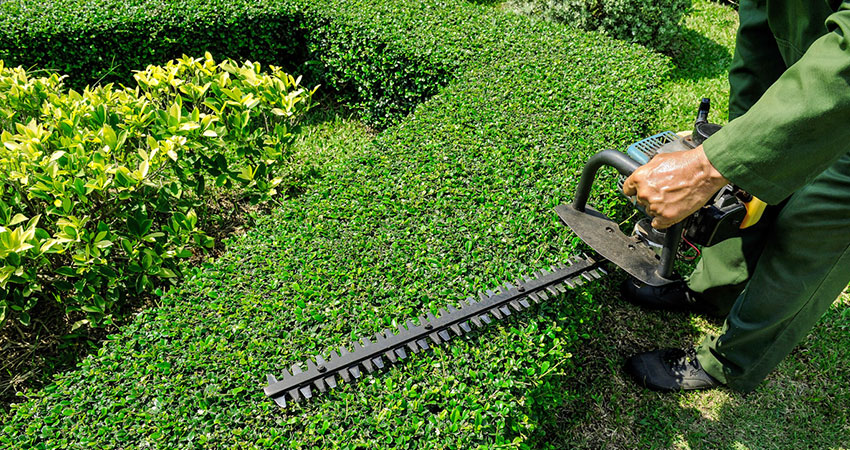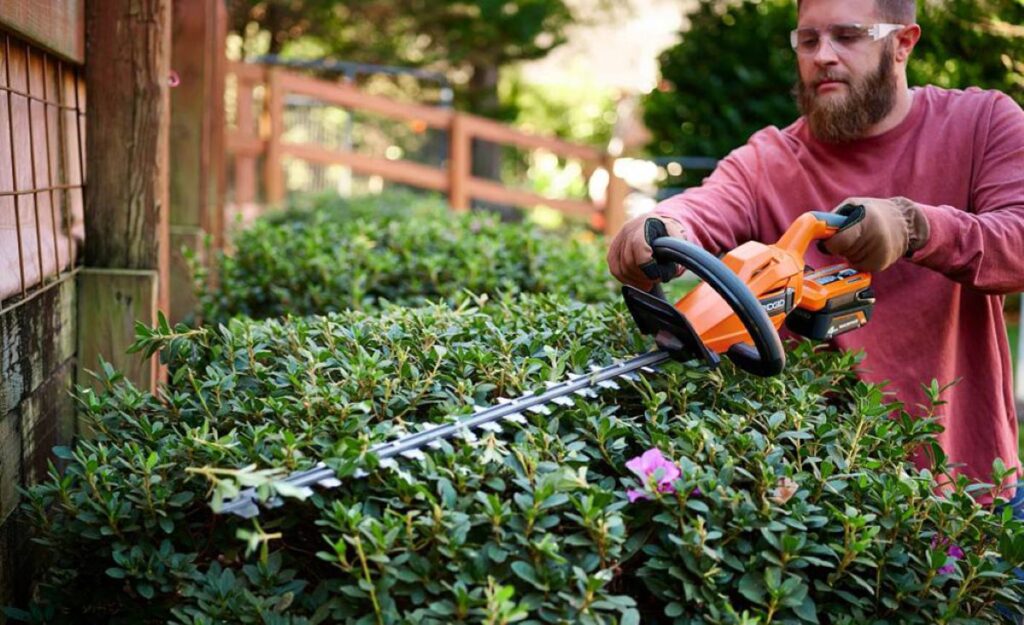A well-maintained garden is the pride of every home, with perfectly trimmed hedges showing off the owner’s dedication and care. Residential hedge trimming can turn an average garden into a breathtaking outdoor area, defining boundaries and adding architectural features that boost property value.
Professional hedge maintenance involves skilled cutting techniques to shape and control growth while keeping the plants healthy. This important gardening task requires:
- Regular trimming to keep hedges at the desired height and width
- Close observation of seasonal growth patterns
- Thoughtful shaping to allow sunlight to reach the interior
- Removal of dead or sick branches
The advantages of regular hedge maintenance go beyond just looking good:
- Increased Privacy: Thick, well-kept hedges act as natural barriers
- Better Air Quality: Lush hedges filter out harmful substances and produce oxygen
- Higher Property Value: Neatly landscaped gardens appeal to potential buyers
- Wildlife Habitat: Properly cared for hedges provide homes for local wildlife
By following a systematic approach to hedge trimming, gardens can stay lively and healthy all year round, bringing lasting beauty and usefulness to residential areas.
The Role of Arborists in Residential Hedge Trimming
Professional arborists bring specialised expertise to residential hedge trimming, ensuring optimal plant health and aesthetic appeal. These certified professionals possess comprehensive knowledge of various tree and hedge species, understanding their growth patterns, maintenance requirements, and potential challenges.
Key Services Provided by Certified Arborists:
- Customised trimming schedules based on hedge species
- Disease identification and treatment
- Structural assessment and correction
- Precision shaping and artistic topiary
- Expert pruning for healthy growth
- Environmental impact considerations
Certified arborists undergo rigorous training and maintain current industry certifications, including ISO standards and memberships with professional organisations such as the International Society of Arboriculture (ISA). This expertise translates into superior hedge care practices that extend beyond basic maintenance.
Professional Equipment and Techniques:
The use of professional-grade tools and equipment by certified arborists ensures:
- Clean, precise cuts that promote healing
- Minimal stress to the plant
- Reduced risk of disease transmission
- Consistent shaping and symmetry
- Safe handling of tall or difficult-to-reach hedges
Arborists also provide valuable guidance on long-term hedge management strategies, considering factors such as:
- Local climate conditions
- Soil quality and drainage
- Growth rate expectations
- Disease prevention measures
- Seasonal maintenance requirements
These professionals carry comprehensive insurance coverage and understand local council regulations regarding hedge maintenance. Their expertise helps prevent common issues such as over-pruning, improper timing, or incorrect cutting techniques that could damage hedge health and appearance.
Understanding Hedge Trimming and Pruning Techniques
Hedge maintenance involves two distinct practices: trimming and pruning. Each serves a specific purpose in maintaining healthy, attractive hedges.
Trimming vs Pruning: Key Differences
- Trimming focuses on maintaining shape and size through regular light cuts
- Pruning involves selective removal of branches to improve plant health and structure
Optimal Timing for Different Hedge Types
Deciduous Hedges
- Late winter pruning encourages vigorous spring growth
- Light trimming during growing season maintains shape
- Avoid heavy pruning in autumn to prevent frost damage
Evergreen Hedges
- Spring pruning promotes dense growth
- Mid-summer trimming maintains neat appearance
- Minimal winter maintenance to protect new growth
Growth Impact and Plant Health
Proper technique application directly affects hedge vitality:
- Cut at 45-degree angles to shed water effectively
- Remove no more than one-third of growth in single session
- Maintain wider base than top for sunlight penetration
- Target dead, diseased, or crossing branches during pruning
- Leave inner branches intact to support future growth
Seasonal Growth Patterns
Different hedge species display varied growth rates:
- Fast-growing varieties need trimming every 4-6 weeks
- Slow-growing species require attention 2-3 times yearly
- New hedges benefit from regular light trimming to establish density
- Mature hedges tolerate more substantial pruning sessions
Professional arborists understand these growth patterns and adjust their techniques accordingly, ensuring healthy hedge development while maintaining aesthetic appeal.
Essential Tools and Equipment for Effective Hedge Trimming
Professional hedge trimming requires specific tools designed for precision and efficiency. The right equipment ensures clean cuts, promotes healthy growth, and creates aesthetically pleasing results.
Essential Hand Tools:
- Sharp bypass secateurs for precise cuts up to 2cm thick
- Long-handled loppers for branches up to 4cm diameter
- Hand shears for detailed trimming and topiary work
- Extension poles for reaching higher branches safely
Power Equipment:
Battery-powered hedge trimmers offer:
- Cordless convenience and mobility
- Reduced noise levels
- Zero emissions
- Lightweight design for reduced fatigue
- Consistent cutting power
- Low maintenance requirements
Safety Equipment:
- Safety glasses
- Cut-resistant gloves
- Non-slip footwear
- Ear protection when using power tools
Tips for Tool Maintenance:
- Clean blades after each use
- Disinfect tools between different hedges
- Sharpen blades regularly
- Store tools in dry conditions
- Replace damaged equipment promptly
Achieving Precise Cuts:
- Use string lines for straight edges
- Apply templates for curved shapes
- Start with larger cuts
- Finish with detailed trimming
- Cut at a slight angle for water runoff
Sharp tools create clean cuts that heal quickly and resist disease. Dull blades can tear plant tissue, leading to brown edges and potential infection points. Regular tool maintenance ensures optimal performance and extends equipment life while promoting healthy hedge growth.
Battery-powered trimmers represent modern technology’s answer to traditional petrol tools. These devices combine power with precision, allowing for extended trimming sessions without the drawbacks of fuel emissions or cord restrictions.
Best Practices for Shaping Hedges with Structural Integrity in Mind
Proper hedge shaping requires a strategic approach that balances aesthetic appeal with structural strength. A well-shaped hedge maintains its form while promoting healthy growth patterns.
Essential Shaping Techniques:
- Start with a wider base that tapers slightly towards the top
- Create a gentle slope on both sides to form an ‘A’ shape
- Maintain consistent angles throughout the hedge length
- Leave the top slightly rounded to prevent snow damage
The tapering technique allows sunlight to reach all parts of the hedge, preventing bare patches and ensuring uniform growth. This shape also promotes natural water distribution, preventing waterlogging at the hedge base.
Structural Considerations:
- Keep the centre of the hedge solid and dense
- Remove crossing branches that weaken the structure
- Cut back any heavy, overextended growth
- Maintain a 2:3 ratio between width and height
Professional arborists recommend regular maintenance cuts rather than aggressive pruning sessions. This approach helps develop a strong branch network and prevents the hedge from becoming too thick or unwieldy.
Key Focus Areas:
- Establish clear sight lines for uniformity
- Create defined edges for crisp appearance
- Remove dead or diseased branches promptly
- Shape gradually to maintain natural growth patterns
A properly shaped hedge acts as a living architecture element, providing structure and definition to garden spaces. The combination of correct angles, appropriate density, and consistent maintenance creates hedges that remain visually appealing while standing strong against environmental pressures.

Benefits of Regular Hedge Maintenance Beyond Aesthetics
Regular hedge maintenance delivers substantial benefits that extend far beyond visual appeal. A well-maintained hedge creates a robust living barrier that serves multiple purposes in residential landscapes.
Dense Growth Benefits:
- Enhanced privacy screening
- Improved noise reduction capabilities
- Natural windbreak protection
- Increased wildlife habitat support
- Better pollinator attraction
The practice of consistent trimming stimulates new growth at the cutting points, resulting in denser foliage. This density creates a more effective barrier against wind, noise, and unwanted views. The thicker growth pattern also provides superior shelter for local wildlife and creates ideal conditions for beneficial insects.
Garden Functionality:
- Natural property boundaries
- Climate control through shade
- Erosion prevention
- Air quality improvement
- Reduced energy costs
Well-maintained hedges act as natural air filters, trapping dust and pollutants while releasing clean oxygen. The dense foliage helps regulate garden temperature by providing shade during summer months and blocking cold winds in winter. This natural climate control can lead to reduced energy costs for adjacent buildings. Click here to get about some tips from tree removal experts.
Health Indicators:
- Uniform growth patterns
- Disease resistance
- Pest prevention
- Strong root development
- Balanced nutrient distribution
Regular maintenance allows early detection of potential health issues. Proper trimming techniques encourage balanced growth throughout the hedge, preventing weak spots and ensuring even nutrient distribution. This proactive approach helps maintain the hedge’s resilience against diseases and pests while promoting strong root development for long-term stability.

Conclusion
Residential hedge trimming is an essential part of garden maintenance, turning outdoor areas into beautiful landscapes. A well-kept garden shows a commitment to taking care of your property and creates a welcoming atmosphere for both residents and guests.
Professional residential hedge care offers:
- Precision and expertise in maintaining complex hedge designs
- Time-efficient solutions for busy homeowners
- Long-term health benefits for garden plants
- Enhanced property value through aesthetic appeal
Hedge trimming is an art that requires specific knowledge, the right tools, and regular attention. While basic maintenance tasks can be done by yourself, professional arborists bring invaluable expertise to difficult situations. Their specialised skills ensure hedges receive appropriate care tailored to species, season, and specific growth patterns.
Consider partnering with certified arborists for the best results in residential hedge maintenance. Their expertise guarantees your garden’s continued beauty and health, making the investment worthwhile for any property owner committed to maintaining exceptional garden aesthetics.
